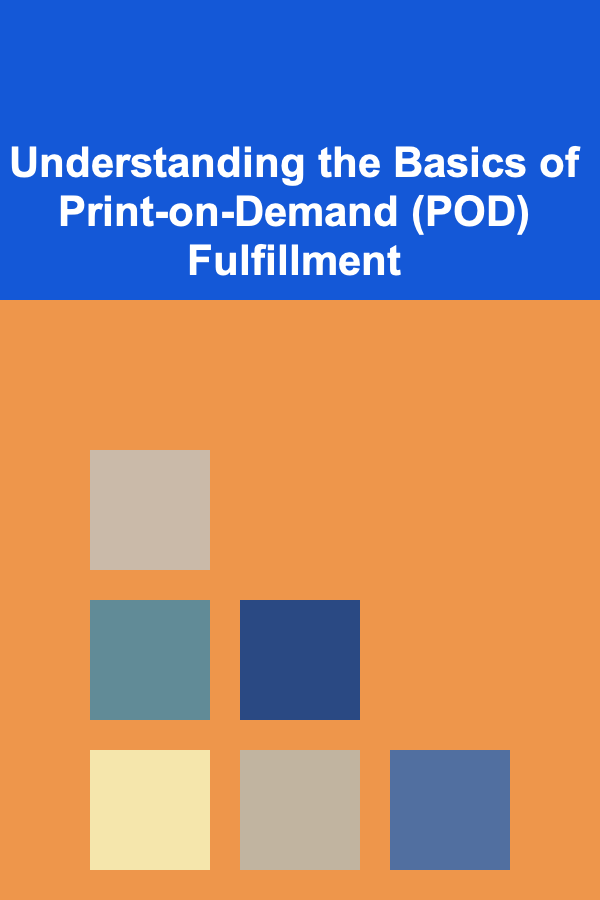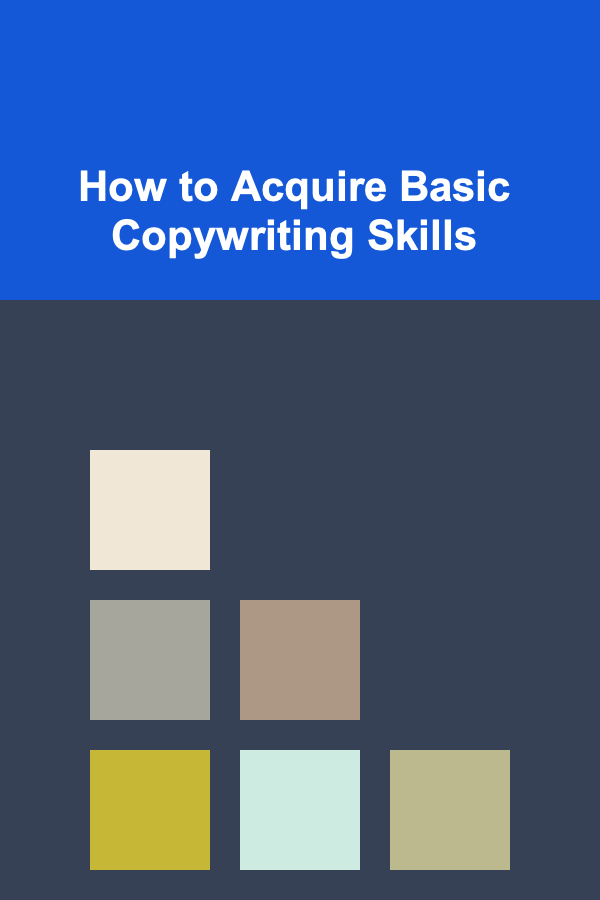
Understanding the Basics of Print-on-Demand (POD) Fulfillment
ebook include PDF & Audio bundle (Micro Guide)
$12.99$8.99
Limited Time Offer! Order within the next:

In today's dynamic e-commerce landscape, Print-on-Demand (POD) fulfillment has emerged as a powerful and accessible model for entrepreneurs, artists, and creators looking to sell custom products without the burden of inventory management. This comprehensive guide will delve into the core principles of POD, exploring its benefits, challenges, and practical considerations for anyone considering leveraging this fulfillment method.
What is Print-on-Demand?
Print-on-Demand is a business model where you collaborate with a third-party supplier to sell custom products. The defining characteristic of POD is that items are only printed or manufactured after an order has been placed. This eliminates the need to hold any physical inventory. When a customer places an order, the POD provider handles everything from printing and packaging to shipping the product directly to the customer.
Essentially, you provide the designs, set the pricing, and market your products. The POD provider handles the rest, allowing you to focus on creativity and sales. This model is particularly appealing for its low upfront costs and reduced risk.
How Does Print-on-Demand Work? A Step-by-Step Overview
Understanding the workflow of POD fulfillment is crucial for success. Here's a breakdown of the key steps involved:
- Design Creation and Upload: The process begins with you creating the designs you want to feature on your products. This could involve graphic design, photography, illustrations, or any other visual art. Once your designs are ready, you upload them to the POD provider's platform. Make sure the designs are high-resolution and properly formatted according to the provider's specifications. Most providers offer templates and guidelines to help you prepare your artwork.
- Product Selection and Customization: Next, you choose the products you want to offer with your designs. POD providers typically offer a wide range of items, including t-shirts, mugs, phone cases, posters, bags, and much more. You can customize the placement and size of your design on each product to achieve the desired look. Consider the product's dimensions and material when selecting a design. A complex design might look great on a t-shirt but might not translate well to a smaller item like a mug.
- Integration with Your Online Store: To start selling, you need to integrate your POD provider with your online store or marketplace. Most POD providers offer seamless integrations with popular e-commerce platforms like Shopify, Etsy, WooCommerce, and Amazon. This integration allows orders placed on your store to be automatically forwarded to the POD provider for fulfillment.
- Customer Places an Order: When a customer visits your online store and purchases a product with your design, the order information is automatically sent to your POD provider.
- Order Processing and Printing: The POD provider receives the order and begins the printing process. They use specialized printing equipment to apply your design to the chosen product. The specific printing technique will depend on the product type and the provider's capabilities.
- Packaging and Shipping: Once the product is printed, the POD provider packages it securely and ships it directly to the customer. They handle all aspects of the shipping process, including packaging materials, shipping labels, and tracking information.
- Customer Receives the Order: The customer receives the product directly from the POD provider, completing the transaction. You, as the seller, don't have to handle any of the physical logistics.
Benefits of Using Print-on-Demand
POD offers numerous advantages, making it an attractive option for various types of businesses and individuals:
- Low Upfront Costs: This is arguably the biggest draw. You don't need to invest in expensive printing equipment, raw materials, or warehouse space. This significantly reduces the financial barrier to entry, allowing you to start selling with minimal capital.
- No Inventory Management: Forget about storing, tracking, and managing inventory. POD eliminates the risk of unsold stock and the associated costs of storage and obsolescence. This frees up your time and resources to focus on other aspects of your business, such as marketing and design.
- Wide Product Selection: POD providers offer a diverse range of products, allowing you to experiment with different offerings and cater to various customer preferences. You can easily add new products to your store without any upfront investment.
- Flexibility and Scalability: POD allows you to quickly adapt to changing market trends and customer demands. You can easily add or remove products from your store and scale your business as needed. The automated fulfillment process ensures that you can handle a large volume of orders without being overwhelmed.
- Test New Ideas: POD provides a risk-free way to test new designs and product ideas. You can launch a new product without investing in a large production run, allowing you to gauge customer interest before committing to larger quantities.
- Focus on Creativity and Marketing: By outsourcing the production and fulfillment process, you can dedicate your time and energy to creating compelling designs, building your brand, and marketing your products effectively.
- Location Independence: You can run your POD business from anywhere in the world with an internet connection. This offers unparalleled flexibility and freedom.
Potential Challenges and Considerations
While POD offers significant benefits, it's important to be aware of the potential challenges and considerations:
- Lower Profit Margins: Since you're paying a third-party for printing and fulfillment, your profit margins will typically be lower than if you were to handle production yourself. Carefully calculate your pricing to ensure that you're making a sufficient profit while remaining competitive.
- Limited Control over Quality: You're relying on the POD provider to maintain quality standards. While most reputable providers have quality control measures in place, it's essential to thoroughly research and vet your chosen provider. Order samples of your products to assess the print quality, material quality, and overall finish.
- Shipping Times: Shipping times can be longer than with traditional fulfillment methods, as the product needs to be printed before it can be shipped. Be transparent about estimated shipping times with your customers to manage expectations.
- Branding Limitations: Some POD providers offer limited branding options, such as custom packaging or branded inserts. If branding is a high priority, choose a provider that offers the customization options you need.
- Dependency on the Provider: Your business is dependent on the POD provider's reliability and performance. If the provider experiences production delays or quality issues, it can negatively impact your business. Choose a provider with a proven track record and robust backup systems.
- Competition: The low barrier to entry means that the POD market can be competitive. You need to differentiate your brand and products to stand out from the crowd.
Choosing the Right POD Provider
Selecting the right POD provider is crucial for the success of your business. Consider the following factors when making your decision:
- Product Catalog: Does the provider offer the types of products you want to sell? Consider the variety, quality, and pricing of the available products.
- Print Quality: Evaluate the quality of the printing methods used by the provider. Request samples to assess the sharpness, color accuracy, and durability of the prints.
- Pricing and Fees: Compare the pricing and fees of different providers. Consider the cost of products, printing, shipping, and any other associated fees.
- Shipping Options and Delivery Times: Check the provider's shipping options and delivery times. Ensure that they offer reliable and timely shipping to your target market.
- Integration Capabilities: Ensure that the provider integrates seamlessly with your chosen e-commerce platform. This will streamline the order fulfillment process and reduce manual work.
- Customer Support: Evaluate the provider's customer support. Do they offer timely and helpful support in case of any issues or questions?
- Reviews and Reputation: Read reviews and testimonials from other users to get an idea of the provider's reputation and reliability.
- Location: Consider the location of the POD provider's facilities. A provider located closer to your target market may be able to offer faster shipping times and lower shipping costs.
- Branding Options: Check what branding options are offered, such as custom packaging slips, neck labels, or other personalized touches.
- Sustainability Practices: If sustainability is important to your brand, look for providers that use eco-friendly materials and printing processes.
Popular POD Platforms and Providers
Several reputable POD platforms and providers cater to different needs and budgets. Here are a few popular options:
- Printful: A well-established and highly regarded POD provider with a wide range of products, robust integrations, and excellent customer support. They offer on-demand warehousing, which can be helpful if you want to sell products you source and store yourself alongside your POD products.
- Printify: A platform that connects you with a network of POD providers around the world, allowing you to choose the best option for your specific needs. This can lead to lower costs and faster shipping times depending on the location of your customers.
- Redbubble: A marketplace where artists can sell their designs on a variety of products. Redbubble handles all aspects of production and fulfillment, making it a convenient option for artists who want to focus solely on creating art.
- Society6: Similar to Redbubble, Society6 is a marketplace that allows artists to sell their designs on a variety of products.
- Gooten: Another popular POD provider with a wide range of products and integrations. They offer advanced features like automated order routing and inventory management.
- SPOD (Spreadshirt Print-on-Demand): Focused on apparel, SPOD offers fast production times and a user-friendly interface.
- Gelato: A global POD platform with a focus on sustainable practices and high-quality prints. They have a large network of printing partners around the world, enabling them to offer fast and reliable delivery.
It's recommended to research and compare several providers before making a decision. Consider ordering samples from each provider to assess the quality of their products and printing. Don't be afraid to experiment with different providers to find the best fit for your business.
Marketing Your POD Products
Creating great designs and choosing the right POD provider are only part of the equation. You also need to effectively market your products to reach your target audience. Here are some marketing strategies to consider:
- Social Media Marketing: Utilize social media platforms like Instagram, Facebook, Pinterest, and TikTok to showcase your designs, engage with your audience, and drive traffic to your online store. Use high-quality images and videos to showcase your products and create compelling content that resonates with your target audience.
- Search Engine Optimization (SEO): Optimize your online store and product listings for search engines like Google. Use relevant keywords in your product titles, descriptions, and tags to improve your search engine rankings.
- Email Marketing: Build an email list and send regular newsletters to promote your products, offer discounts, and announce new designs. Email marketing is a highly effective way to stay in touch with your customers and drive repeat sales.
- Paid Advertising: Consider using paid advertising platforms like Google Ads and Facebook Ads to reach a wider audience and drive targeted traffic to your online store. Carefully target your ads to reach people who are likely to be interested in your products.
- Influencer Marketing: Collaborate with influencers in your niche to promote your products to their followers. Influencer marketing can be a highly effective way to reach a large and engaged audience.
- Content Marketing: Create valuable content that attracts and engages your target audience. This could include blog posts, articles, videos, and infographics related to your designs or your niche.
- Affiliate Marketing: Partner with other websites and businesses to promote your products in exchange for a commission on sales.
- Run Promotions and Discounts: Offer regular promotions and discounts to incentivize purchases and attract new customers.
- High-Quality Product Photography: Invest in professional-looking product photos. Visual appeal is extremely important for online sales, especially for print-on-demand products.
- Customer Reviews: Encourage customers to leave reviews. Positive reviews build trust and can significantly impact sales.
Pricing Your POD Products for Profit
Pricing your POD products effectively is crucial for achieving profitability. Consider the following factors when setting your prices:
- Cost of Goods Sold (COGS): Calculate the cost of each product, including the base cost from the POD provider, printing costs, and any other associated fees.
- Marketing and Advertising Costs: Factor in the cost of marketing and advertising your products.
- Shipping Costs: Consider the cost of shipping your products to customers. You can either charge customers for shipping or offer free shipping and factor the cost into your product prices.
- Profit Margin: Determine your desired profit margin. A common rule of thumb is to aim for a profit margin of 30-50%, but this can vary depending on your industry and target market.
- Competitor Pricing: Research the pricing of similar products offered by your competitors. You don't necessarily need to match their prices, but it's important to be aware of the market landscape.
- Perceived Value: Consider the perceived value of your products. If your designs are unique and high-quality, you may be able to charge a premium price.
- Experiment and Adjust: Don't be afraid to experiment with different pricing strategies to see what works best for your business. Track your sales and profitability closely and adjust your prices accordingly.
A simple formula for calculating your retail price is: Retail Price = (COGS + Marketing Costs + Shipping Costs) / (1 - Desired Profit Margin)
Legal Considerations
When running a POD business, it's important to be aware of the legal considerations involved:
- Copyright and Trademark: Ensure that you have the rights to use all designs, images, and text that you use on your products. Avoid using copyrighted or trademarked material without permission.
- Privacy Policy: Have a clear and comprehensive privacy policy on your website that explains how you collect, use, and protect customer data.
- Terms and Conditions: Have clear and concise terms and conditions that outline the rules and regulations of your business.
- Sales Tax: Be aware of your sales tax obligations and collect and remit sales tax as required by law.
- Business Licenses and Permits: Check whether you need any business licenses or permits to operate your POD business in your location.
Conclusion: Is POD Right for You?
Print-on-Demand offers a compelling business model for anyone looking to sell custom products with minimal upfront investment and risk. However, it's not a "get rich quick" scheme. Success requires careful planning, diligent effort, and a focus on creating high-quality designs, providing excellent customer service, and effectively marketing your products.
If you're creative, entrepreneurial, and willing to put in the work, POD can be a rewarding and profitable way to build your own online business. By understanding the basics of POD fulfillment and carefully considering the factors outlined in this guide, you can position yourself for success in this exciting and rapidly growing industry.

How to Choose the Right Pet Food for Your Furry Friend
Read More
How to Host a Friendsgiving Party That Everyone Will Love
Read More
Passive Income with Deep Learning: Tips for Beginners
Read More
Voiceover Artist's Handbook: From Beginner to Professional in the Industry
Read More
How to Acquire Basic Copywriting Skills
Read More
Understanding Quantum Machine Learning
Read MoreOther Products

How to Choose the Right Pet Food for Your Furry Friend
Read More
How to Host a Friendsgiving Party That Everyone Will Love
Read More
Passive Income with Deep Learning: Tips for Beginners
Read More
Voiceover Artist's Handbook: From Beginner to Professional in the Industry
Read More
How to Acquire Basic Copywriting Skills
Read More